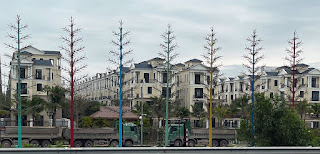March 6th
The first day of my 8th decade on this planet! The good news about the connected world is receiving birthday wishes from so many. Tien even shows up this morning with a birthday cake! Today, we are off to our cruise on Ha Long Bay, a 2.5 hr drive east of Hanoi. This is the mouth of the Red River, so we are passing prime farmland on both sides of the road. Up in the distance we see a city rising from the rice paddies:
We see many of what look like pagodas out in the middle of the rice paddies:
Tien tells us that most of these are village cemeteries and are very important to families as they practice ancestor worship. (Tien says that his 7th great grandfather is buried in his family plot in his home village). Occasionally, someone will have no children. Before they die, they build their own shrine in the middle of their fields and make arrangements to donate the land to the village when they die. It is law that if you use a field, you must take care of any shrine on the land so in this way, their memory is preserved.
In the distance, we see the bustling port of Haiphong. I remember this name because during the war, this was a major target for fighter bombers based on aircraft carriers further off the coast of the Gulf of Tonkin. Almost everything we see has been built since the mid-1990s. We see this building:
Karst mountains form when the limestone rock is partially covered by a hard cap rock. The limestone under the cap layer stays intact while all of the rest of the limestone erodes away leaving these weird shapes. Tien says we are lucky because although it is completely overcast, this is the first time he's been able to see the karst from the highway in the last 10 days.
We've been driving for a couple of hours so Tien asks the driver to pull into a rest area so that we can use the toilet and get some caffeine. Tien brings Chris and Mark coffee and Beth and I a kind of flower tea. It has a floral and slightly sweet taste. Next to the coffee shop is another one of those opportunities to separate tourists from their hard currency. This is a shop selling cultured pearls and mother-of-pearl gifts.
As we get closer to the port, we see a lot of signs of damage from the typhoon (uprooted trees, buildings without roofs). Tien tells us that most people were without power for several days and that the mayor of Ha Long was fired because power still had not been restored a week later.
We get to the reception area for the cruise, say goodbye to Tien, and hand our suitcases off to staff. The harbor is packed with all manner of cruise ships, and we wonder which one is ours. After about 30 minutes, a small (20-30 people) boat arrives to take us to our ship which is moored in another harbor. We put on our life jackets and the boat pulls out. Our guide tells us that it will take about 25 minutes to get to our ship. All along the way are bigger and bigger and newer ships than we saw in Ha Long so we are really wondering what ours will look like. Finally, our guide announces that we are arriving. Here is our ship, designed to look like one of the original Vietnamese ships:
We arrive at the back of our ship and come on board. The crew is playing drums to welcome us. At the reception area, we pick up our keys and are told that we will have a buffet lunch followed by our first excursion, which will be a choice of a speedboat ride or a walk on a beach. As we are eating, the ship is moving to a new location closer to where our excursions will take place. As expected, Beth and Chris go for the speedboat. I go for the beach and Mark decides not to do either.
It turned out I was the only one who went to the beach, but I had a good time taking closeups of karst and watching a French family of kayakers making signs in the sand like a group of castaways. Here are some of the pictures I took:
Back on the boat, we are asked to put on the costumes in our closet for dinner. These are supposed to look like the outfits that the ancient kings of Vietnam wore a thousand years ago during the time they were under the control of the Chinese. Not surprisingly, my pants are too small, so we exchange them for a larger size.
Dinner is five small courses and there is a musician playing an erhu - a Chinese two-stringed fiddle. He didn't play anything that sounded Chinese or Vietnamese, but we did hear him play everything from Mozart to Simon & Garfunkel! At the end of dinner, all the lights go out and all of the servers are lined up behind the musician and carrying two birthday cakes - one that Tien had given us and another that the chef made. Their version of Happy Birthday was very interesting. Not a great moment for an introvert, but it has certainly been an interesting day! The video of the birthday song is too long to post here, but here is a link: Steve's Birthday












Happy birthday
ReplyDelete